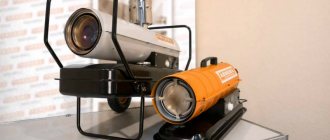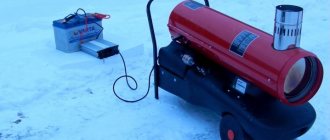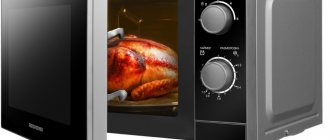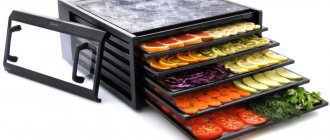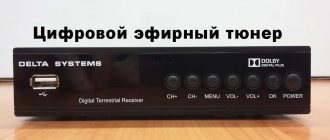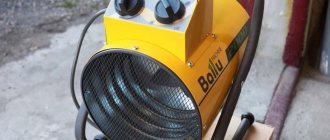Heat guns are high-power heating devices that are used to heat indoor air or create comfortable heat flows outdoors (for various purposes).
Heat guns are divided according to the type of energy used to heat the air:
- electrical;
- diesel;
- gas;
Diesel and gas are also divided into:
- direct action;
- indirect action.
Direct action heat guns
Direct-acting heat guns are used only in well-ventilated rooms and outdoors, due to the principle of their operation.
And the operating principle is based on the combustion of a flammable substance (in this case, diesel fuel) in a special chamber, which ensures its complete combustion. The efficiency of direct heating heat guns is close to 100 percent, but heating occurs with combustion products containing a high content of carbon dioxide and harmful substances.
The combustible substance is supplied to the combustion chamber from the fuel tank by a pump or using an air compressor, which creates a vacuum in the area of the nozzle with a jet of air, which (the vacuum) is enough to lift diesel fuel from the tank (atomizer principle).
Unlike their gas and electric counterparts, diesel heat guns have a fuel supply system, which complicates the system and makes it more expensive. Diesel fuel can be contaminated with impurities and foreign matter, so the power system requires routine maintenance and filters (if any) need to be replaced.
BISON gun "MASTER" thermal, gas, 10.0 kW, TPG-10000_M2
Diesel heat guns are quite efficient and remain an indispensable means of heating in some situations in which it is impossible (or undesirable) to use other types of heaters.
Transportation of diesel fuel is more convenient and safer than gas cylinders (which need to be stored, refueled, transported somewhere), and connecting an electric heat gun of comparable power and comparable efficiency can be problematic.
A full tank of a diesel heat gun (depending on the power and intensity of operation) is enough for 10-15 hours of continuous operation, and a solid fuel supply (up to 50 liters or more) allows you to fill it once per shift.
Heating control
In addition to heating intensity, many models provide power adjustment. Using a step switch, you can use full power for quick heating or partial power to maintain heat in an already heated room, for example, or if the heating equipment is used as an additional source of heating. By the way, some models have a fan mode without heating.
What else can be included in the operation of an electric heat gun? An overheat protection system is important. During operation, when a critical temperature threshold is reached or if the case is accidentally covered with something, the protective system will work and heating will stop.
Diesel heat guns for indirect heating
Diesel heat guns of indirect heating allow the use of these heaters in rooms with people and animals, since the toxic exhaust is discharged separately. An additional heating circuit allows you to separate the flow of clean heated air and hot exhaust gases.
The exhaust pipe is located at the top of the heat gun and allows you to connect a fire-resistant hose to discharge combustion products to the street or into the chimney.
Clean air is pumped by a fan through the heating chamber, which is heated from the outside by a flame of combusted diesel fuel. The efficiency of indirectly heated diesel heat guns is naturally lower than that of direct heated diesel heat guns, but remains quite high.
For the operation of power systems, automatic ignition, fans, and protection systems, mains (or any other) electrical voltage is required.
Electrical energy consumption is mainly required to operate an electric fan (usually of low power 50-200 Watts),
piezo ignition or spark plugs.
If mains electricity is unavailable, diesel heat guns can be powered from a generator or battery with an inverter (a device that converts the battery's 12 Volt DC into 220 Volt AC).
An automated control system allows diesel (and other) heat guns to operate without human intervention, that is, a built-in thermostat that controls the ambient temperature issues a command to turn off or ignite the heating equipment.
To avoid emergency situations, heating devices are equipped with a protection system when the fan stops, which reacts to an increase in temperature in the combustion chamber and shuts off the fuel supply.
In more complex models, rollover sensors, oxygen control in the air, flame attenuation, etc. may be installed.
Thermal gun BISON "MASTER" COMPACT ZTP-M1-5000
How to choose models by power
What is the most important thing in choosing an electric heat gun? Choose the right heating power. The volume of air that will warm up during operation depends on it. This is a guideline when purchasing a unit for a specific area. For example, a 2 kW model has an air flow of 120 cubic meters per hour, and a 3 kW gun has a heat flow of 300 cubic meters per hour.
A simplified selection scheme will be as follows: a power of 1 kW is enough to heat 10 square meters. m (provided that the ceiling height is no more than 3 m).
A more accurate calculation is made using the formula, where the calculated power is denoted by the letter P. This takes into account not the area of the room, but its volume, as well as the thermal conductivity of the walls.
Let's look at an example. The area of the room is 10 square meters. m, and the ceiling height is 3 m. This means that the volume of the room will be 30 cubic meters. m. Let's assume that the temperature inside it should be +15 °C, and outside -20 °C. This means that the difference between these values will be 35 °C. Let's assume that the walls of the building are well insulated and take a thermal conductivity coefficient of 1.
Let's calculate the required power: (30*35*1)/860=1.22 kW. This means that in a room of 10 square meters. m, a heat gun with a power of 1.22 kW or more is suitable for comfortable heating in winter. However, it is better to buy a model with a small margin, for example with an indicator of 1.5 kW.
If we classify heating equipment by power, then models up to 5 kW are considered household. Such heat guns operate from a 220 V electrical network and can be used in dachas, garages, offices, and private homes. Sometimes they are also called fan heaters. Industrial models can reach several tens of kilowatts in power, which means they place a significant load on the network and must be connected to a network with a voltage of 380 V. They are capable of heating large premises: hangars, workshops, workshops. A hint when choosing a heat gun will be the power table.
It is important to know! Not all heat guns come complete with a power cord and plug. Therefore, they are purchased separately.
Gas heat guns
Gas heat guns are simpler than diesel ones due to the lack of fuel supply and filtration systems, so their price is much lower.
Combustible gas is supplied under pressure from a gas cylinder or line, which is why some models of gas heat guns are supplied with gas reducers.
When gas burns, not a lot of harmful substances are released, so gas heat guns of even high power (70 kW or more) are found in a direct version, that is, without exhaust removal (but provision of air access and ventilation are stipulated).
When operating gas heat guns, do not forget that at low temperatures, the evaporation of gas in the cylinders slows down greatly and the pressure may not be enough to start the automatic heating device.
The minimum operating gas pressure is within 0.5 bar.
The automation system monitors the temperature in the burner area and, when the flame dies out, tries to ignite it again (up to three times), and if the flame does not ignite, it shuts off the gas supply.
Gas heat guns are quite efficient heating devices (up to 100 kW and above), and the ability to use 100 percent efficiency makes these units, in some conditions, the best choice.
Infrared
Heat IR gun
An infrared gun is different from others in that it does not have a fan system that typically heats the air.
A special mechanism makes it work using infrared radiation, due to which the air heats up and the entire room is heated.
The air is heated during the process of heat transfer.
An infrared gun can not heat the entire room at once, but only a certain area of it.
This quality is especially necessary during construction and repair work, when, for example, you need to dry walls or floors after plaster has been applied to them.
Electric heat guns
An example of an electric heat gun is a hair dryer, but it is not intended for long-term use.
If it is possible to connect to the electrical network with sufficient power, electric guns will be preferable to their diesel and gas counterparts.
To connect electric heat guns up to 5 kW, a single-phase 220 Volt network is sufficient; when connecting more powerful electrical appliances, a three-phase 380 Volt network is used.
Wires made of alloys with high resistance and different cross-sectional geometries are used as heating elements.
A heating element is a tubular electric heater made in a closed form; a nichrome wire is placed inside the tube, where high-temperature dielectrics are used as an insulator. When opened, it is a wire (nichrome or fechrome) twisted into a spiral, located on ceramic insulators.
Electric heat guns are easy to use, easy to manufacture, easy to adjust, inexpensive, and quite safe.
ZUBR "EXPERT" "Square" thermal electric gun ZTPE-24000-F_M2
Negative factors include the high cost of electricity and the incompatibility of electrical appliances with moisture, dampness and water, in any form.
Electric heat guns are produced in a fireproof design, and the use of heating elements makes them even safer.
With proper connection, operation and use of residual current devices (RCDs), electric heating devices can be considered the simplest and most comfortable to use.
Which is better to choose?
An electric convector, fan heater, and oil heater look like much more common solutions for heating a home than a heat gun. But you won’t be able to use them as the main heating device.
A heat gun, even an electric one, is also not suitable for all rooms. For example, it is better to install a silent and safe convector in a child’s room or bedroom.
The choice of a heat gun is usually determined by the need to quickly warm up large rooms that are not heated on a regular basis . Dry the basement, ensure the correct temperature for drying the concrete screed, maintain a comfortable atmosphere in a greenhouse or country house - such heating equipment can cope with these tasks 100%. In winter, electric heat guns are used by repair specialists, and in the garage they can be used to quickly warm up the air if you need to “defrost” the car.
Heat guns, when used on an ongoing basis, turn out to be much more expensive to operate. Compared to oil heaters, they consume energy 3-5 or more times more intense. Such a purchase will be profitable only if there are no other heating alternatives.
Operating rules
Heat guns of any design (electric, gas, diesel) are not allowed to be covered, as this leads to disruption of air circulation and overheating.
Heat guns cannot be used in cramped conditions, that is, direct the air flow towards an obstacle, which also leads to disruption of air circulation.
Ventilation and access to fresh air are a prerequisite for the operation of powerful heating devices, since heat guns burn oxygen.
When using heat guns in production or construction, it is necessary to take into account that heavy dust levels lead to failure or fire hazard.
Before putting it into operation for the first time, read the manufacturer's instructions and follow its recommendations.

